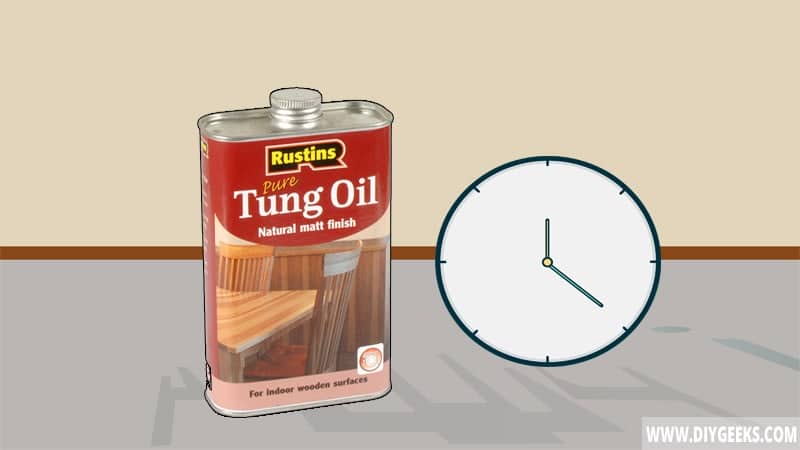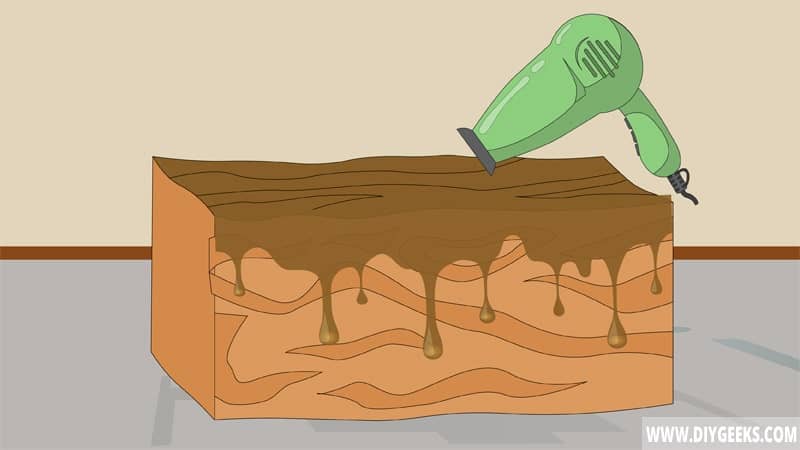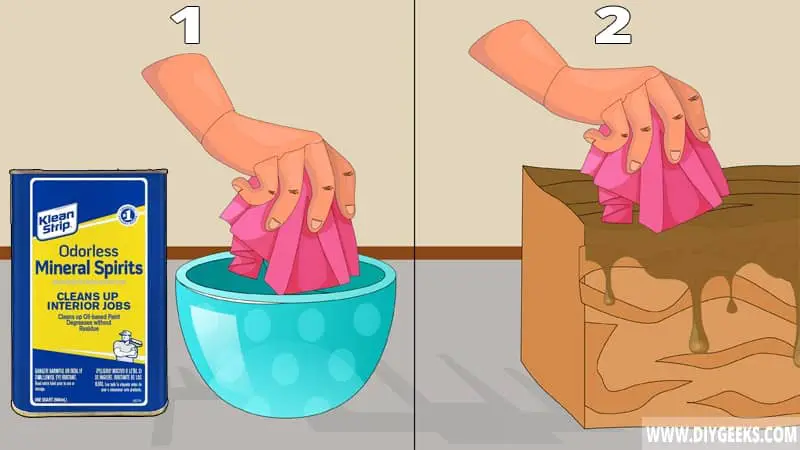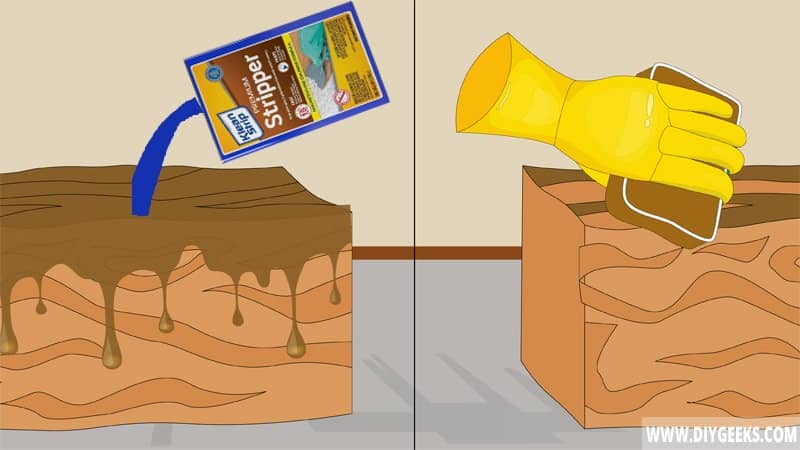A sticky Tung oil refers to a Tung oil finish that doesn’t achieve the desired hardness and remains sticky (or tacky) after application.
The reasons Tung oil turns sticky include low room temperature, improper surface prep, or if you apply too many Tung oil coats.
The fixes for sticky Tung oil include using a Hair dryer, wiping the excess, or removing the Tung oil and re-applying it.
Why Does Tung Oil Turn Sticky?
Tung oil turns sticky for the following reasons.
- Low Room Temperature.
- Improper Surface Prep.
- You Applied Too Many Tung Oil Coats.
- You didn’t wipe the excess.
- Re-coated too soon.
- You applied Raw Tung oil.
The usual cause of a Tung oil sticky finish is unfavorable drying conditions. Tung oil is a wood oil finish that is picky when it comes to ideal drying conditions.
1. Low Room Temperature
Tung oil won’t dry in time and turns sticky if you apply it when the temperature is lower than 50°F (10°C) and humidity is higher than 50%. A low room temperature and high humidity levels prevent the solvent (oil) from evaporating and the coating from drying.
To speed up tung oil drying time, Increase the room temperature with a heater or use a dehumidifier to decrease the humidity levels.
2. Improper Surface Prep
Tung oil won’t adhere or dry properly and can turn tacky if the surface is dirty, bumpy, wet, or already sealed.
If you apply Tung oil over wet wood, the moisture in the surface will prevent the wood oil from adhering or drying properly, causing it to remain wet for longer.
If you apply Tung oil over a sealed (finished) surface, it won’t adhere or dry over it as the sealer will prevent it from penetrating the surface. Tung oil will stay over the top layer of wood and remain wet there.
3. You Applied Too Many Tung Oil Coats
If you apply too many Tung oil coats, there will be more wood oil than the wood can absorb, resulting in a wet and sticky finish. The excess Tung oil will remain on the wood top layer and turn gummy or sticky.
4. You Didn’t Wipe Off The Excess
You must wipe Tung oil excess 30 minutes after applying it. Tung oil will penetrate the wood pores within 30 minutes, so you must wipe off the remaining to prevent a tacky finish.
5. Re-coated Too Soon
If you re-coat Tung oil too soon, the existing coat solvent (oil) will prevent the new coating from adhering or drying, creating a wet sticky finish.
Before you re-coat Tung oil, the existing coat solvent (oil) must evaporate and the surface must become rigid (hard). Tung oil takes around 24 hours to dry between coats.
6. You Applied Raw Tung Oil
Raw Tung oil contains no metalized dryers or quick-drying additives that accelerate its drying time. It takes longer to dry and remains wet (or sticky) longer than normal Tung oil.
Does Tacky Tung Oil Dry Eventually?

Sticky tung oil does dry eventually if it’s caused by low room temperature, if applied too much of it, if you didn’t wipe the excess, or if you re-coated it too soon. Simply wipe the excess Tung oil from the surface, and increase the heat around the coating to help the solvent (oil) evaporate faster.
Sticky tung oil doesn’t dry eventually if it’s caused by improper surface prep or if more than 48 hours have passed and the coating is still wet. If the surface is wet or sealed, the Tung oil coating won’t dry over it as the moisture (or sealer) will prevent it from adhering or drying.
If the Tung oil is still sticky 48 hours after applying it, it won’t dry as there’s something preventing it from drying. You must remove the entire finish, fix the surface issues, and re-apply it.
How To Fix Sticky Tung Oil?
To fix sticky Tung oil, do one of the following things.
- Use a Hair dryer.
- Wipe the Excess Tung oil.
- Remove and Re-apply Tung oil.
1. Use a Hair dryer

Since Tung oil dries through solvent evaporation, use a hair dryer to increase the heat around the coating and accelerate the evaporation rate. If you expose a sticky finish to increased heat, the solvent (oil) will evaporate faster and the coating will dry.
Use this method within 24 hours of applying Tung oil. If the sticky finish is solidified, this method doesn’t work.
The tools you need for this method are listed below.
- A hairdryer
- Fans
- A pair of gloves
Here is a guide for this method:
- Use the hair dryer at medium temperature.
- Move the hair dryer over the wet sticky coating for 5 minutes.
- Wait 20 minutes.
- Use the hair dryer again for 5 minutes.
- Turn off the hair dryer and allow the coating to dry naturally.
Don’t dry a sticky wet coating fully with a hair dryer as it will cause it to dry too fast and prevent the particles from bonding or drying naturally. This will lead to a cracked finish.
2. Wipe the Excess Tung Oil

If there’s too much Tung oil on the surface, wipe the excess and allow the remaining to dry. Wood can’t absorb too much Tung oil, so the remaining stays over the top layer and turns sticky (or tacky).
You must wipe the excess Tung oil 30 minutes after applying it. This reduces the amount of wood oil on the surface and allows it to dry faster.
The tools you need for this method are listed below.
- Mineral spirits
- Clean rags
- Plastic bags
- A pair of gloves
- A natural-bristled paintbrush
- Polymerized Tung oil
Here is a guide for this method:
- Damp a rag with mineral spirits.
- Use the dampened rag to wipe the sticky Tung oil.
- Sprinkle mineral spirits directly over the finish.
- Wait 30 minutes.
- Use a dry rag to wipe the excess Tung oil.
- Allow the remaining to dry naturally.
- Touch up the finish if needed.
3. Remove and Re-apply Tung oil

Remove and re-apply Tung oil if there’s a surface issue that prevents it from drying. If the surface is wet or sealed, the moisture (or sealer) prevent Tung oil from penetrating the wood surface and drying.
If there’s a surface issue, such as a water leak, the wood oil can’t adhere or dry over it. You must fix the surface issues and then apply the wood oil.
To remove the Tung oil finish, do one of the following things.
- Apply mineral spirits over the finish.
- Use a solvent-based paint stripper or wood oil remover.
- Use a coarse-grit sandpaper (40-grit) to remove it.
- Use acetone and steel wool to dissolve and remove it,
How To Know if Tung Oil Has Dried?
Tung oil has dried when the following things happen.
- The finish is water-resistant. Tung oil coating is water-resistant once it dries. Pour water over the finish, and if the water isn’t absorbed, the finish has dried.
- The finish has a honey-like color shade. The honey-like color shade is produced once the Tung oil has dried.
- The finish is hard and durable. Tung oil reaches its maximum durability, strength, and adhesion once it cures (fully dries).
- The finish isn’t sticky or tacky.
How to Prevent Sticky Tung Oil?
To prevent sticky Tung oil, do the following things.
- Leave enough dry time between coats.
- Always follow the manufacturer’s instructions when applying it.
- Apply it only in optimal drying conditions.
- Wipe off the excess after application.
- Wipe, clean, and sand the wood before applying it.


